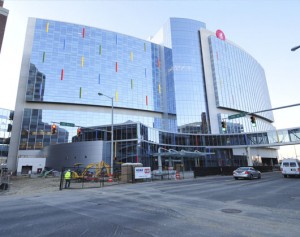Children’s of Alabama’s Benjamin Russell Hospital for Children expansion is the first healthcare facility in Alabama, and one of the first of its kind in the U.S., to gain LEED-Gold status as a result of its design and use of sustainable, energy-efficient and environmentally responsible materials. KLMK Group served as project manager, Hoar Construction in partnership with BE&K served as construction managers and HKS, Inc., in partnership with Giattina Aycock Studio, served as architects. Giattina Aycock Studio oversaw the green aspects of the project.
 Mike Warren, CEO/president of Children’s, said that green design creates an environment of wellness that is in line with the mission of the state’s only freestanding pediatric hospital and was an important part of the effort to reach its sustainability targets.
Mike Warren, CEO/president of Children’s, said that green design creates an environment of wellness that is in line with the mission of the state’s only freestanding pediatric hospital and was an important part of the effort to reach its sustainability targets.
“We have the responsibility and privilege to serve the families of our community,” he said. “That includes not only providing exceptional pediatric healthcare, but also being good stewards of our shared environment. The expansion was designed with careful consideration for the environment affected around it and created within it.”
Children’s opened the $400-million, 670,000-square-feet expansion in August 2012. The hospital expansion will accommodate projected growth in patient volume, anticipated medical technology needs, consolidation of services and a family centered design to enhance patient and family comfort. Pediatric cardiovascular surgery and related services and solid organ transplant services were moved from the nearby University of Alabama at Birmingham to Children’s. Construction expenses will be recovered in the long term because green buildings use less energy, less water, require less maintenance and last longer.
A partial list of sustainability initiatives includes:
- Materials from recycled raw materials were used for construction and 30-40 percent of the construction waste was recycled. Widespread use of local materials also reduced fuel costs for transportation. Natural materials, including recycled mirrors and seashells were used in the terrazzo flooring in public areas of the hospital.
- Energy-efficient mechanical systems were installed that are 30 percent energy efficient than those in comparably built hospitals being constructed.
- The north-south orientation of the building and the use of exterior glass in every room will also help save on energy costs.
- Large glass windows allow plentiful natural light into the building; all patient rooms, waiting rooms and staff break rooms get light from outside.
- Up to 30,000 gallons of condensate are collected from the building’s air conditioning system and used for irrigation and also to cool equipment. Designated “green” space on Children’s campus on 17th Street between 5th and 6th avenues, including a water feature where children can play,and 140 bicycle racks also contribute to the hospital’s earth-friendly profile.
- Ground floor exterior landscaping incorporates a variety of plantings indigenous to the area, providing an oasis of green amid the hospital’s urban setting. More plantings are planned to highlight pedestrian access to Birmingham’s award-winning Railroad Reservation Park three blocks to the north.
- The rooftop garden of the Benjamin Russell Hospital for Children is planted with sedum, a low-maintenance, heat- and drought-tolerant ground cover native to Alabama. The rooftop landscaping reduces heat absorption and stormwater runoff and also provides insulation and oxygenation.
- Features of the expansion include the recycling and reuse of building materials salvaged from the demolition of two outdated buildings that were located on the construction site; selection of low-emission building materials and reduction of construction activity pollution.
- Extensive use of low-energy LED lighting in public interior spaces.
Incorporating green design into the building of a hospital typically adds 2-4 percent to the construction budget. Such costs in the Children’s project were underwritten by a portion of a $10-million gift from Birmingham-based McWane, Inc. and the McWane Foundation challenging Children’s of Alabama to build an energy-efficient and environmentally sensitive facility, which would also be an example for the state. Phillip McWane has served on the Children’s Hospital Board of Trustees since 1985.





